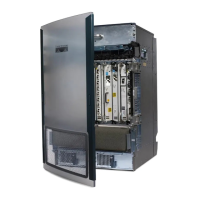4-76
Cisco IOS XR Getting Started Guide for the Cisco XR 12000 Series Router
OL-24755-01
Chapter 4 Configuring Additional Router Features
Configuring the Domain Name and Domain Name Server
4. end or commit
5. show hosts
DETAILED STEPS
Command or Action Purpose
Step 1
configure
Example:
RP/0/0/CPU0:router# configure
Enters global configuration mode.
Step 2
domain name domain-name-of-organization
Example:
RP/0/0/CPU0:router(config)# domain name
cisco.com
Defines a default domain name used to complete
unqualified hostnames.
Step 3
domain name-server ipv4-address
Example:
RP/0/0/CPU0:router(config)# domain name-server
192.168.1.111
Specifies the address of a name server to use for name and
address resolution (hosts that supply name information).
Note You can enter up to six addresses, but only one for
each command.
Step 4
end
or
commit
Example:
RP/0/0/CPU0:router(config)# end
or
RP/0/0/CPU0:router(config)# commit
Saves configuration changes.
• When you issue the end command, the system prompts
you to commit changes:
Uncommitted changes found, commit them before
exiting(yes/no/cancel)?
[cancel]:
–
Entering yes saves configuration changes to the
running configuration file, exits the configuration
session, and returns the router to EXEC mode.
–
Entering no exits the configuration session and
returns the router to EXEC mode without
committing the configuration changes.
–
Entering cancel leaves the router in the current
configuration session without exiting or
committing the configuration changes.
• Use the commit command to save the configuration
changes to the running configuration file and remain
within the configuration session.
Step 5
show hosts
Example:
RP/0/0/CPU0:router(config)# show hosts
Displays all configured name servers.

